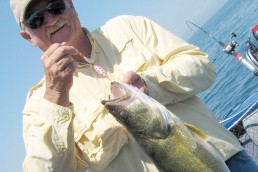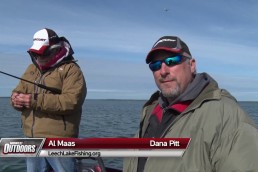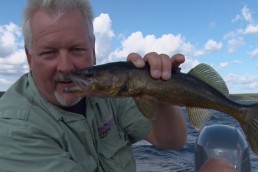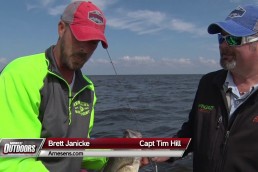2020 Lake Erie Walleye Population
SHARE THIS POST
As this season has proven, biologists are correct to say that 2020 and the next several years will be the best walleye fishing in Lake Erie in decades. Sorry Lake of the Woods, Lake Erie is indisputably the true “Walleye Capital of the World.”
The Coronavirus had things in turmoil this spring, with the Ohio Department of Natural Resources, Division of Wildlife suspending sales of non-resident fishing licenses during much of April and early May to enforce social distancing.
For those who had purchased their licenses earlier and for residents, the walleye fishing on Lake Erie and the Maumee River in the spring was nothing short of phenomenal. The weather was especially cooperative, with the calmest month of April in memory.
Outstanding catches were made by trollers and jiggers fishing familiar spawning locations all spring, but due to the number of walleyes inundating the lake, overflow catches were regularly made outside their normal spawning structures.
According to Travis Hartman, Ohio Division of Wildlife’s Lake Erie Program Administrator, Lake Erie’s walleye population for 2020 is an estimated 116 million catchable fish, with a staggering 151 million fish expected to swim the lake after the 2019 year-class enter the fishery in 2021 as 15-inch legal quarry.
While the outstanding walleye hatches in 2015, 2018 and 2019 will sustain the fishery for years to come, more modest but good hatches in 2014 and 2017 and a decent one in 2016 add to the stockpile of older fish which provide numerous trophy opportunities.
An abundant, but dwindling 2003 year-class may yet produce a record fish to replace the current Ohio record of 16.19 pounds which has been in place since 1999. State of the art aging techniques using the otoliths instead of scale rings have revealed that Lake Erie walleyes can live to be at least 25 years old.
Walleye and yellow perch Total Allowable Catches (TAC) set
On March 26, the Great Lakes Fish Commission’s Lake Erie binational committee, comprised of fisheries managers from all of the jurisdictions that surround the lake, released the 2020 (TAC) limits for walleye and yellow perch. These are based upon current populations, fishing industry feedback and the overall goal to annually maintain sustainable harvests.
The Lake Erie TAC for walleye will rise from 8.531 million in 2019 to 10.237 fish for 2020 and the perch TAC decreases from 8.552 to 7.805 million pounds from 2019 to 2020 due to rising and fall populations respectively of these 2 most important species. Walleyes are managed by numbers and perch by weight.
Walleye
The walleye TAC is 20 percent higher than last year, with Ohio receiving 5.232 million, Ontario allowed 4.408 million and Michigan’s quota is 597,000 fish respectively. Pennsylvania and New York set their harvest limits to fall in line with TAC objectives.
Last year’s catch rates were 0.83 walleyes per hour, nearly double the harvest rates of the infamous 1980’s walleye boom and represents the best fishing in the 40-year history of Lake Erie’s creel surveys, boasts Hartman.
The increased catch rates, along with the daily limit increase to 6 walleyes year-round this season could result in Ohio closing in on its 5.2 million fish allotted quota, especially if additional fishing effort in the form of using a now-legal third rod boosts the total annual harvest.
The 2018 walleye fishing effort was estimated by creel surveys to be 2.4 million hours, with the harvest ending up at 1.972 million fish in Ohio. Last year, the targeted walleye fishing effort rose to 3.1 million hours, 2.560 million walleyes kept from the Ohio waters of Lake Erie. According to Hartman, this is the highest catch in 26 years, since the 1993 harvest.
To ensure that the good fishing continues in the event that the lake sustains any years with poor recruitment, the daily bag limits will not be raised in these times of plenty. But, because of the higher populations allowing Ohio’s TAC to eclipse the 3 million fish mark, the spring bag limit of 4 was raised to 6 year-round beginning this year.
Anglers who want to experience the lake’s trophy fish and fast fishing should be sure to visit Lake Erie for walleyes in the coming years, as the population has climbed to astounding modern year highs. Their condition continues to remain excellent, with plenty of forage fish species still available.
Are you enjoying this post?
You can be among the first to get the latest info on where to go, what to use and how to use it!
Yellow perch
The TAC for yellow perch dropped from 8.552 million pounds in 2019 to 7.805 million pounds this year. It allows Ontario to harvest 3.737 million pounds, with Ohio allocated 3.139, Michigan earmarked for 0.192, Pennsylvania assigned 0.534 and New York apportioned 0.203 million pounds respectively.
Ohio’s TAC for each of its 3 perch management units are all set at approximately 1 million pounds. These are high enough to still allocate 35 percent of the perch quota to the commercial trap netters, while the daily limit will remain at 30 lake wide for Ohio sport anglers, according to Hartman.
Despite favorable hatches in the Western Basin during most of the past several years, catch rates have slowed since 2017 as fishing has suffered by changing diet shifts by perch to more abundant prey.
Stomach content analyses have determined that over the past few years that fish are targeting more invertebrates, primarily midge larvae and spiny water fleas, an introduced European zooplankton.
The numbers of spiny water fleas have exploded in recent summer, causing the perch to suspend in the water column as they seek clouds of this zooplankton prey.
While the 2018 perch hatch was good again in the Western Basin and saw a modest increase in the Central Basin, they will be too small to enter the fishery until 2021, explained Hartman.
Central Basin perch spawning continues to disappoint, and numbers are much lower than those seen during the most recent higher catches occurring from 2013-2016. Days of counting on limits of perch exceeding a ½ pound per fish average are a fading memory for those of us who fished from Conneaut to Ashtabula 5 to 10 years ago. The yellow perch bag limit remains at 30 fish for Ohio waters.
Black bass
While the Black bass (Smallmouth and Largemouth) is predominantly a catch and release fishery, creel survey data indicated that there were approximately 5,000 Smallmouth bass kept from Ohio waters in 2019.
Increasingly, Largemouth bass have been targeted and even caught outside the harbors and shallow embayments where they would be expected to be living among the weed beds.
Other considerations
The now annual Harmful Algal Blooms affecting Lake Erie’s Western Basin during the summer gets a lot of press, but according to NOAA’s first forecast on May 13, they expect a smaller outbreak of the toxic scum this summer. Lower precipitation levels seen this spring have reduced the nutrient concentrations in the Maumee River watershed.
Lake levels are similar to last year’s record highs. Especially during an east wind, this can cause localized flooding within the low-lying Western Basin marinas, onto the roads from Oak Harbor to Marblehead, and even into some of the Port Clinton business establishments.
Become a MidWest Outdoors Insider here!
MWO
SHARE THIS POST
Did you enjoy this post?
You can be among the first to get the latest info on where to go, what to use and how to use it!
John Hageman
John Hageman was manager of Stone Laboratory, Ohio Sea Grant's Biology Station at Put-in-Bay, for 25 years and formerly a licensed Lake Erie ice-fishing guide. He is active with the Outdoor Writers of Ohio and several sportsmen's conservation organizations. He may be contacted at hageman.2@osu.edu.



